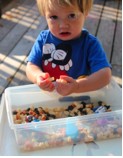 Every Tuesday morning, his smile radiates the minute he sees his developmental therapist walk through the door. Each week, she brings an oversized bag filled with toys, which might as well be magical to my 1-year-old.
Every Tuesday morning, his smile radiates the minute he sees his developmental therapist walk through the door. Each week, she brings an oversized bag filled with toys, which might as well be magical to my 1-year-old.
As we continue to navigate Joshua’s ongoing medical issues and developmental delays, I learn more and more about his seizure disorder and just how important playtime is for him. A recent routine EEG revealed that his epilepsy may be a lifelong ordeal, but the most life-changing news was that there is damage/scarring to the front temporal lobe. According to his neurologist, this will inhibit his ability to learn how to verbally communicate, and physically his coordination will be “off”, meaning he’ll more than likely always be clumsy.
“Abnormal results” ranks pretty high up there in things I’d rather not hear from my growing toddler’s specialist. And after hearing these latest results, more than ever, playtime is crucial for Joshua’s development.
Like most toddlers, Joshua is curious. He enjoys discovering his surroundings and takes great joy in turning everything within reach upside down. During a recent Developmental Intervention session, the therapist noted how my normally curious tot wanted nothing to do with Play-Doh. The cold, squishy, yet smooth texture was an annoyance. After a few short minutes, he signed that he was “all done”. Strangely, he’s always wanted to play with Play-Doh when big brother and I play together. Yet, when put in front of him during a fun therapy session where it’s his “job” to play, Joshua had issues with Play-Doh.
I have no idea if Josh’s sensory processing issues and epilepsy are correlated, or if it’s just a toddler thing. But whatever it is, it’s always comforting to know that there’s always a way to integrate playtime into his routine. To help with Joshua’s brain development and to reinforce his curiosity, his therapist recommended creating a sensory box.
According to Highscope.org, “Sensory play also contributes in crucial ways to brain development. Think of it as ‘food for the brain.’ Stimulating the senses sends signals to children’s brains that help to strengthen neural pathways important for all types of learning. For example, as children explore sensory materials, they develop their sense of touch, which lays the foundation for learning other skills, such as identifying objects by touch, and using fine-motor muscles.”
Sensory play at home has transcended the classic sandbox. Parents are creating homemade sensory bins filled with small toys mixed with a myriad of fillers. I’ve seen the popularity of sensory bins in my educational, kid-centric Pinterest boards—you know those clear plastic shoe boxes filled with uncooked rice or other types of tiny fillers with loads of hidden toys and objects. I’ve seen holiday-themed sensory bins with mini plush pumpkins and plastic black cats for Halloween, and mini snowmen and sparkly ornaments for Christmas. And according to the imagery of sensory bins for toddlers on Pinterest, the shinier, brighter, and quirkier the toys and fillers, the better.
The thing about creating sensory bins is that there’s really no right or wrong, and the possibilities are truly endless. This hands-on activity promotes sensory exploration and loads of open-ended play. I’m looking forward to putting together some fun sensory bins as much as I am looking forward to watching my curious boy play.

